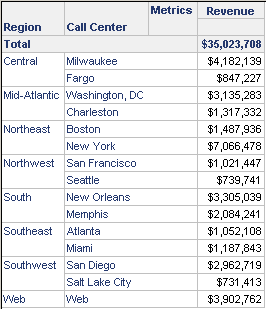MicroStrategy ONE
Calculating grand totals for metrics: header and footer sections
Before you begin
This topic assumes that you understand the levels of metric calculation on a report. For background information, see About metrics. It also assumes that you are familiar with the different document sections. For descriptions of the document sections, see Understanding and working with document sections.
A metric placed in a text field in any header or footer section other than a Group Header or Group Footer is calculated as a grand total, totaled across the entire dataset. These document sections include:
-
Layout Headers and Layout Footers are only displayed in multi-layout documents.
For example, a report contains the Region and Call Center attributes, as well as the Revenue metric. A portion of this report is shown below. The report contains a grand total to help you compare metric values between the report and the document.

This report is used as a dataset for a document. The Revenue metric is placed in text fields in the Page Header, Document Header, and Detail Header. Note that it is not placed in the Detail section, so the Call Center revenue values are not displayed. Labels are included in each document section, to indicate the different groups.

Notice that the metric values are the same for all the document sections, and they match the grand total calculated in the report. Which document section you place the metric in depends on where you want the information to appear, for instance, the top or bottom of each page (Page Header or Page Footer) or at the beginning or end of the document (Document Header or Document Footer).
The preceding example uses metrics in text fields. Metric values in a Grid/Graph in these document sections are calculated at the level of the Grid/Graph. For details and an example, see Calculating metrics at the level of a Grid/Graph and a group: Group Headers and Group Footers.
The calculation of grand totals is determined by the metric's definition, specifically by the dynamic aggregation function. For more information on how dynamic aggregation works in documents, see Dynamic aggregation in documents. Summary metrics explicitly set the aggregation function; this is their primary role. For other user-defined metrics, the function specified in the definition is also used as the aggregation function, if the function is SUM, MIN, or MAX. For instructions on creating metrics in documents, see Creating metrics in documents.
